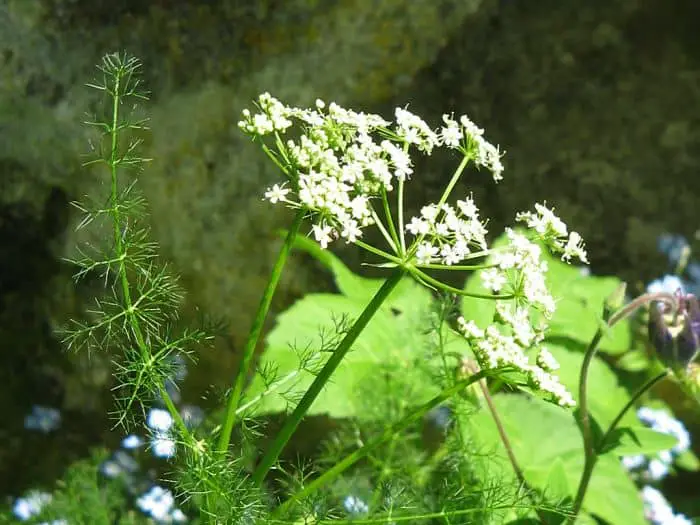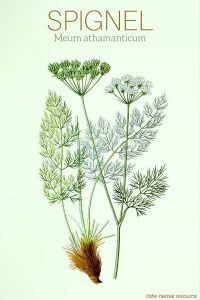Botanical Name: Meum athamanticum.
Spignel is the only member (monotypic) belonging to the plant genus Meum.
Other Common Names: Spignel, baldmoney, wood spignel, spicknel, spikenel, mew, meu, bearwort, fenouil des Alpes (French), meo (Spanish), bjørnerod (Danish), Bärwurz (German), snauskjoldblom (Norwegian), sköldpaddsört (Swedish).
Habitat: Spignel is native to the mountainous areas of Western Europe and Central Europe, its range extends south to Andalucia in Spain and to central Bulgaria in the Balkans.
Description: Spignel is a hardy perennial plant belonging to the parsley family (Apiaceae) that can grow up to 40 cm tall.
The rootstock is strong and produces a long erect stem with dark green, narrow and triangular leaves growing near the base.
The yellow-white flowers form an inflorescence and appear from July to August. The fruit (seed) is 5-10 mm long, elongated, slightly compressed and reddish brown.
The plant tolerates most soil types but thrives best in a nutritious soil that retains moisture in the summer. It grows best in full sun or half shade.
Spignel is easiest to propagate by root division from well-established plants early in the autumn.
Plant Parts Used: Today, it is mainly the leaves that are used, mostly as a spice or as a garnish but the root and seeds can also be used in cooking.
In the past, the dried root, seeds, and leaves were used to some extent as herbal medicine.
The leaves have the best flavor in the spring and they are not suitable for drying.
The roots of three-year-old plants can be dug up in early autumn and used fresh as vegetable and spice.
Liquid extracts (tinctures) can also be made from the roots.
Therapeutic Application, Benefits and Traditional Uses of Spignel
Active Ingredient and Substances
Information regarding the plant’s constituents is, as of yet, lacking, but it is known that the plant contains essential oil, resin, gum, starch, sugar, and a fatty oil.
Traditional Uses of Spignel
Spignel has not been used much as a medicinal plant, but it has been used at least to some extent as a folk medicine in the mountainous regions of Europe where the plant grows wild.
Probably most popular application of the herb is in the form of a liquid extract, known as “Bärwurz schnapps”.
In addition, the root has been used as a tea to relieve indigestion, improve appetite and balance irregular menstrual cycles.
The English botanist and herbalist, Nicholas Culpeper (1616 – 1654) mentioned the use of spignel in his writing, where he wrote that it was an excellent herb to improve both appetite and digestion and that it should work well as a remedy for excessive flatulence, belching, colic, and stomach aches.
According to Culpeper, the powdered root should be administered along with sugar, or as an extract of the root in water, white wine or beer and taken every morning and evening for few days, in order to regulate menstruation, ease childbirth and to promote the expulsion of the afterbirth.
The root of spignel is similar, both in flavor and its effects, to the roots of angelica and lovage, and can be used in similar ways as these two plants to treat excessive intestinal gas (flatulence) and other uncomplicated digestive problems.
Both the root and leaves of spignel have a reputation as a good treatment for snake bites and coughs, and in the past, it was believed that an alcohol extract of the herb had aphrodisiac properties.
Spignel as a Spice
The leaves of spignel have a flavor reminiscent of curry and the herb is locally often referred to as “the curry plant”.
The finely chopped leaves can be used to spice up soups, potato dishes, omelets, fish, meat and vegetable dishes, or in any curry dishes as a replacement.
In addition, the chopped leaves can be used to add a sprinkle of green and a light curry flavor to egg sandwiches, cheeses, fish balls, and white or light sauces.
The whole leaves can be added to meat and fish dishes.
The root has a powerful, spicy taste and can be suitable as a spice for casseroles and soups.
In the Scottish Highlands, the roots were once used as a vegetable and the seeds were used as a substitute for pepper or other aromatic spices.
Dosage and Administration
The root can either be used in tea form, as an extract or just by chewing on the dried root.
Potential Side Effects of Spignel
Spignel is considered a safe herb to use either as vegetables, spice or herbal medicine.
Supporting References
Allen, David E. & Gabrielle Hatfield: Medicinal Plants in Folk Tradition. An Ethnobotany of Britain & Ireland. Portland / Cambridge, Timber Press 2004.
Darwin, Tess: The Scots Herbal. The Plant Lore of Scotland. Edinburgh, Birlinn Ltd 2008.
Grieve, Mrs. M.: A Modern Herbal. London, Penguin Books 1980.
Hensel, Wolfgang: Medicinal Plants of Britain and Europe. London, A&C Black Publishers Ltd. 2008.
Potterton, David (ed.): Culpeper’s Colour Herbal. Berkshire, Foulsham 2007.
Thordur Sturluson
Latest posts by Thordur Sturluson (see all)
- What is the Difference Between Hemp and Marijuana? - June 3, 2019


Leave a Reply